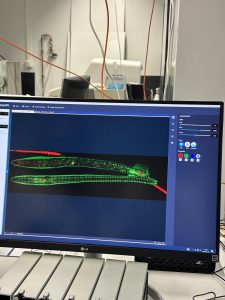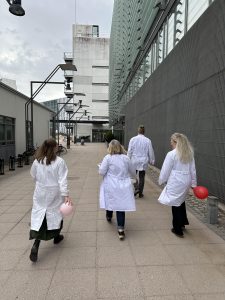My HiLIFE traineeship has come to an end, and although it is sad to close a chapter, I couldn’t be more excited to share how my experience went.
I am Mireia Pagès Guitart, I just graduated with an MSc in Pharmaceutical Research, Development, and Safety at the University of Helsinki. In September 2023, I started an incredible project at Michael Jeltsch’s lab to tackle a huge sustainability challenge with one of the best tools at our disposal: science. You can learn more about it by reading my previous post, by clicking here. In January 2024, HiLIFE supported my investigation by awarding me the HiLIFE research traineeship. Do you wonder how it ended up? Keep reading!
After months of reading, testing, failing, achieving and, most importantly, having fun, I am happy to share that I succeeded in expressing GFP in vitro. Unexpectedly, it turned out that earthworms have inherent green fluorescence. Therefore we could not be sure whether the green color after in vivo imaging was due to our protein or due to the animal. Even so, my project was a big step forward to achieve our goal: developing a sustainable animal model for protein production and microplastic degradation. You might wonder: what now? I will continue my journey in Catalonia (for now) and my lab team will continue this amazing project… so be aware of a promising future!

The HiLIFE traineeship made me realize I enjoy research more than I thought! Doing extra hours, having to check up on the cells during weekends, and messing up experiments doesn’t matter if you have science at your heart. During my experience, I thought about the thin line between a job and a hobby, and how my project became my pastime. Feeling this way towards research couldn’t have been possible without being surrounded by a comforting team. I am aware of how lucky I was to find a lab that matched my energy, sense of humor and enthusiasm for research.

Joining a research group goes beyond the lab work. I was proud to join workshops, competitions, conferences and talks that were as important to grow as a scientist. The value of grasping every opportunity during my stay brought out the bookworm inside me. Nothing but good outcomes in my research and personal progress came afterwards. I encourage future HiLIFE trainees to make the most out of their traineeship.

Over my master’s at the University of Helsinki and my stay at the lab, I have internalized many learning lessons from which I want to share three:
- Whatever you do, stay curious and skeptical, and, above all, enjoy the journey because there is no other destination (by my PI Michael).
- Sometimes you think you have been buried, but actually, you have been planted (by the activist Christine Caine)
- Surround yourself with people who are different from you: open your eyes and envision your view of this small world with big souls (by my friend Achmet).

A chapter closes and another begins. Farewells are sad, but they remind you of the people that you have met along the way, and that you can proudly call them friends. They remind you of your social impact on new environments, and how people learn from you as much as you gain from others. Farewells are not a goodbye, but a “see you later”!
In catalan I would say: aquesta experiència no ha sigut bufar i fer ampolles, però res extraordinari ho és! – this experience hasn’t been easy, but nothing extraordinary is.




